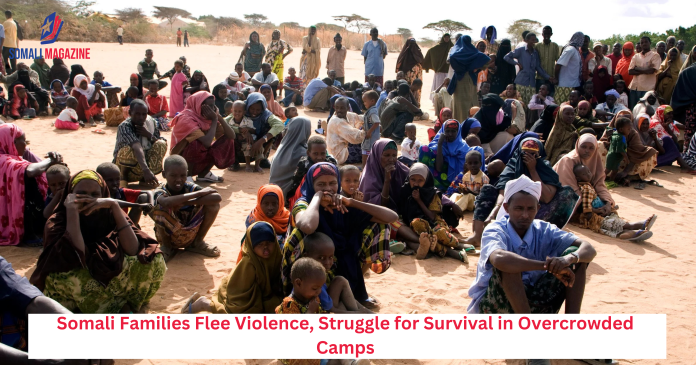Facebook Twitter (X) Instagram Somali Magazine - People's Magazine
Hundreds of displaced families, especially women and children, face hunger and hardship after escaping the ongoing war in Middle Shabelle
Hundreds of families in Somalia have been forced to leave their homes in the Middle Shabelle region due to fighting between the Somali government and the militant group Al-Shabaab. The violence has caused great suffering for those affected, especially women and children.
One of those affected is Maryan Nur Mohamed, a mother of eight. She arrived at Hilac-Wanaag camp in Garasbaley, Mogadishu, in April after escaping the war. Her family now lives in a crowded hall along with about 100 other families. They sleep on mats and share a few bottles of water. Maryan says they usually eat only once a day and often go to bed hungry.
Maryan used to live a peaceful life with her family on their farm in Ceel-Baraf. They grew food and raised goats. But everything changed when fighting suddenly broke out. Her husband was killed by Al-Shabaab in 2020 after refusing to give them livestock. When shelling began again, she had to flee with her children, leaving behind their crops and goats. A kind businessman helped them escape in his car.
Life in the camp is very difficult. Maryan’s youngest child is just three years old and struggles with hunger. She says they used to work hard and eat from their farm, but now they rely on the kindness of strangers. Many days, they receive nothing.
Another mother, Fowsiya Abukar Ali, also fled with her 11 children in early March. She now lives in Hilaac camp in Mogadishu. Since arriving, she has struggled to feed her children. Most days, they go without food or eat only once. She says she has no cooking utensils, no home, and sometimes only drinks water as food. She and her children sleep outside, suffering from the heat during the day and the cold at night.
Fowsiya’s journey was long and dangerous. She walked for five hours with her children to reach Mahaday, where relatives took them by car to Mogadishu. She shared that her brothers were killed in an airstrike while hiding on a farm. Her husband stayed behind to protect their own farm, which was later bombed and burned. He has no money to join them, and she has no one in Mogadishu to support her.
Maymun Mahmoud Yusuf is another mother who escaped the violence. She fled from the Bushra Sheikh area in Adale with her three children. Their house was destroyed in the war. They had nothing when they arrived in Mogadishu—no money, no belongings. Maymun says they depend on what little people can give, and sometimes they go days without food.
When families arrive in Mogadishu, they are often dropped off at the roadside. Local people have been trying to help as much as they can. Mohamed Aweys Mohamed, a community member, said 1,500 families have been placed in 15 different camps, with 300 of them in Hilac-Wanaag. He and his neighbors gathered whatever they could—rice, sugar, oil, blankets, even small amounts of money—to help the new arrivals.
According to the UN’s humanitarian agency (OCHA), over 30,000 families have been affected by the conflict in Middle Shabelle. Many have moved to nearby areas like Hiran, Banadir, and safer parts of Middle Shabelle. Most displaced families—mainly women and children—arrive with nothing but the clothes they are wearing. So far, they have received little or no help from official aid organizations.
These families urgently need food, shelter, clean water, and support. Many are still suffering as the conflict continues, and there is no sign of when they will be able to return home.

